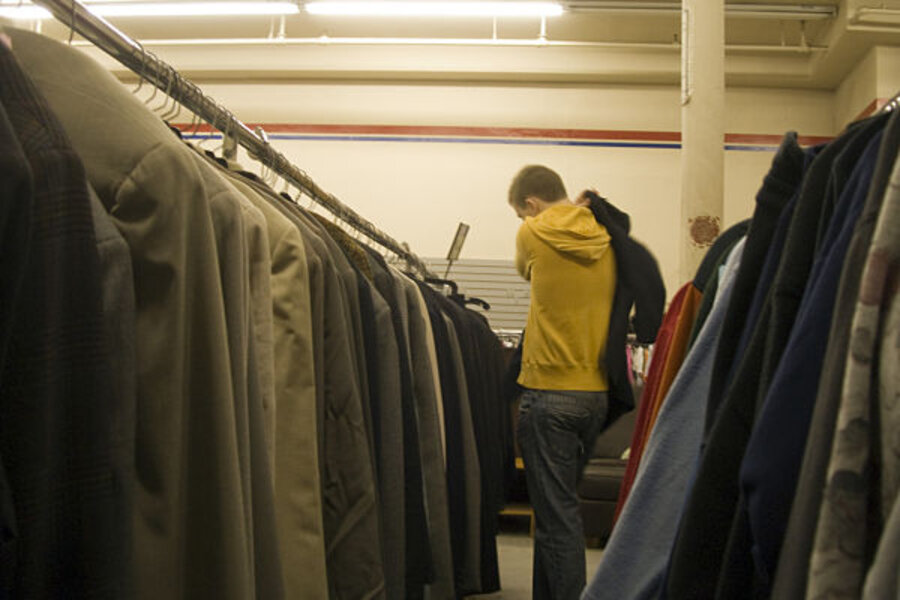Old Navy 30 percent off? Why not clothes at 90 percent off?
Loading...
Monica writes in:
I don’t understand how you can recommend that people shop in thrift stores for clothes. The stuff there is usually worn out and just looks bad and outdated. I would never wear that stuff to work.
It sounds to me like you’ve made up your mind about thrift stores and secondhand stores before even stepping inside the door. I’ll make the case anyway.
First of all, I won’t buy the vast majority of clothing on sale at such a store. I’m with Monica on this one – most of the stuff there can be pretty worn out. I’ve seen lots of threadbare sweaters, worn out dress pants, and other items that, if they were in my home, would be meeting the rag bag.
Those aren’t the items I’m shopping for. The reason I go is to look through a long rack of clothes and find two or three items that are barely worn. How do quality items of clothing get to the secondhand store? A person gains or loses a lot of weight. A person passes away. A person decides they just don’t like how the item looks on them. A person is a clotheshorse who only wears an item a couple of times before getting rid of it. Each of these cases can result in some very nice clothes on the rack at the secondhand shop.
If you don’t like the item, don’t buy it. However, there are a lot of gems buried on the racks if you’ll spend some time digging through them.
Second, my biggest focus for clothing buys – once they meet a minimum standard of quality – really is cost per use. Yes, unquestionably, I could go to a store like Men’s Wearhouse, find a high quality article of clothing, and wear it, say, sixty times over the course of several years. That article of clothing might cost me $60, so the cost per use would be $1 per use.
On the other hand, I might find a nice item at the secondhand store. It might have been worn a few times already, so I might only get fifteen wears out of it instead of the sixty I might get from the new shirt. However, that secondhand item only cost me $3. That’s $0.20 per use.
I will take the second item of clothing any day of the week.
What about the time cost? Time cost is one of the first things people mention when they hear a money-saving tactic that they’re unsure about. Human beings are creatures of habit and if we can find a good reason to retain that habit (or even a not-so-good reason), we’ll use it. Time cost is often that reason.
However, in this situation, time cost matters little. I go clothes shopping twice a year, period.
In the spring, I’ll dig out all of my summer clothes (in fact, I’m intending to do this this weekend), determine what needs to go and what can stay, and then figure out if I need to add some clothes to the mix or if I have enough. I do the same thing in the fall with my winter clothes.
Once that’s done, I actually make a shopping list for clothes. I need some number of dress shirts, some number of jeans, some number of shorts, some number of khakis, some number of underwear – you get the idea. Then, I go shopping.
If I use secondhand store clothes in this process, I still just rotate them out at season’s end if they’re too worn, the same thing I’ll do with clothes that are purchased new. I’ll still go clothes shopping twice a year, regardless of whether I’ve bought new or used clothes in the past.
What this comes down to is simple: spending control. I keep a pretty tight rein on my clothes shopping habits. I simply don’t go clothes shopping more than twice a year. Because of that, I don’t devote much time in a given calendar year to picking out new clothes – and I don’t spend nearly as much money, either.
At its heart, an awful lot of frugality and financial success comes down to control over your spending. If you have firm control over how your money leaves your wallet, it’s often shocking how many ways there are to cut your spending without cutting your quality of life one iota.
Add/view comments on this post.
--------------------------
The Christian Science Monitor has assembled a diverse group of the best economy-related bloggers out there. Our guest bloggers are not employed or directed by the Monitor and the views expressed are the bloggers' own, as is responsibility for the content of their blogs. To contact us about a blogger, click here. To add or view a comment on a guest blog, please go to the blogger's own site by clicking on the link above.





